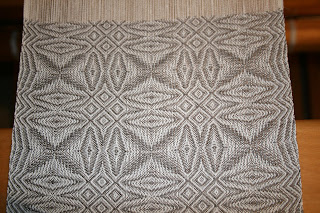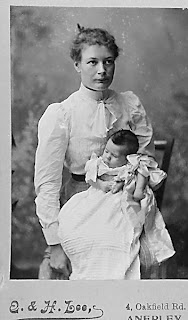I hadn't been weaving for too long when I found some old material at a second hand store. It was just a scrap in a basket of old doilies and linen hankies. The pattern was amazing! I bought it for a dollar and later found out it was snowflake twill in off white and beige cotton.... with an orange stripe down one side. I didn't like the orange line but some weaver long ago placed it there and had a good reason to do so. I was going to photograph the fabric to show you and have been taking my studio and linen cupboard apart to find it but no luck! ( If you click here... this link will take you to a post where I show the antique cloth and also more snowflake scarves more recently finished )
Then came a blizzard of snowflakes!! Weavers Magazine issue number 13, 2nd quarter 1991 and before too long issue number 18, 3rd quarter 1992 and then issue number 20, 1st quarter 1993. Seems I wasn't the only one who liked the pattern work and there was a demand for more! They featured more projects in Weavers issue number 35, Spring 1997 again. Even the recent fall 2012 Handwoven magazine featured a reprise of snowflake once more. Its like "eye candy"!
Over the years I have woven endless yards of snowflake twill in scarves, shawls and table runners. I have never used it for kitchen towels as that would seem sacrilegious somehow, but there's no reason why it couldn't be done. It would be a lot of work for a towel you wipe dishes with! It seems to be a draft I turn to time and again. So much so, I can recite the entire treadling by memory... forward and backwards!
Its known as snowflake twill, or Swedish snowflake twill, which is interesting since Guild of Canadian Weavers Masterweaver Jane Evans wrote her thesis on Latvian weaves. It was later published as this (sadly) out of print book:
So what is snowflake twill? Its technically a twill progression. A ever progressing twill run to a mid point and then mirror reversal. This detail (below) shows a typical 8 shaft run that creates the "X" formation:
 |
| Notice the zig zag runs below the threading |
There is a whole world of twill progressions out there, so if this inspires you to look further, then great!
In the best of Weavers "Twill Thrills" they show a lovely heart shaped motif so once you get the concept, its fun to play with and see what you can come up with. (Granted, a computer program makes this much easier and I use Fiberworks-PCW.)
Fair warning! It seems to gently lead you further, deeper into the next weaving world of Network Twills like the rabbit diving into the hole in Alice in Wonderland! (The best guide introductory guide for network twills, and theory on most weave structures, is Madelyn van der Hoogt's "The Complete Drafting Book for Handweavers")
Then you link the motifs together with either satin threading (note the beautiful cross style pattern created between the X's):
My favourite method is to use a point twill threading in between. Jane Evans had a lovely runner featuring this method in Weavers Magazine issue number 18:
It certainly adds more drama!
Table runner, in fine mercerised cottons, 36 epi.
Smooth yarns really show the pattern nicely and square the pattern better, and I have used various weights up to size 10/2 (or 2/10) cotton but anything larger in grist would have a float problem. Having said that, I have seen a lap throw in medium sized wool and it looked stunning! The wool has the ability to hold the twill floats in place, particularly if fulled a tad. Its produces a nice balanced pattern if you use the same size yarn as both warp and weft, otherwise the X's become elongated and just look weird.
I also tend to use soft neutral colours as the pattern can get rather busy visually and even more so with bolder colour. Again, some years ago I used cream silk as warp and black silk as weft and it was snapped up at a sale! The woman buyer had what I would like to call, an "exuberance for fashion and flair." Back in 2005-2006 I was commissioned to weave an all black snowflake twill shawl. It was hard on the eyes but it was stunning! I didn't have a digital camera then unfortunately.
I like to use one matte yarn and one shiny one to get a beautiful play of light on the cloth to reveal the pattern. This way it looks great on a table with the wood :
This is the table runner I gifted my son and daughter in law this past spring.
I personally haven't woven a four shaft version but I did venture into twelve shaft territory for my sister's shawl. ( all details are fully covered in three posts on "Melinda's Shawl" are shown on the sidebar, under "Topic Shopping") I used a fine off white tencel (shiny) and used a silk seaweed blend weft (semi matte). The X's get to be rather large as you can see from this picture. That's a six inch ruler for one repeat:
So does it always have to be an X? No... you can get a squared O from the same draft! With the regular threading in place, simply treadle the reverse of the threading: (can you spot the mistake? :)
Here's another twist on this. The threading and treadling are reversed...... and it produces
.... you get X's! Reverse one direction, either the threading or treadling and the O's are back.
This picture was awkward to get and then Blogger turned it for you, but you can see the line. What caused it? One warp end that didn't get threaded through the eye of the heddle, but just below it. If it had been above the eye then the line would have appeared on top and been caught right away. The top looked just fine!
There are some threading lines but they tend to coincide with the three ends per dent in my twelve dent reed. I'm not going to tell you how many inches of silk yak blend I cut and pulled out. I wanted to save the warp and not get the fuzzies. I let it sit for a few days after fixing the warp thread. The warp and I needed a time out.
The warp is bleached camel and silk blend and not overly shiny and the (now scrapped) silk yak was not all that shiny either. Now I had a chance to change up the weft (notice how I'm looking for the positive here?) I used a 20/2 silk for the first scarf for a tone on tone. The lines are quite visible but they are not errors. They are three thread groupings through the reed that coincide with the pattern groupings. Believe me, I double checked!!
The second scarf is currently under way and I'm using a beige silk and camel blend and it has a beautiful golden sheen. Its a finer weft and so the pattern repeats are smaller... and there's a whole lot of weaving to get the inches in!
I also have a scarf warp going on the Louet as well and so took time out to weave a scarf there. This project needs my close attention as well when treadling ...yes, its another twill. Are you surprised?











































.jpg)

